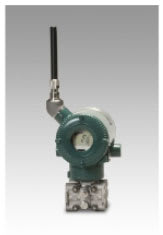Requirements
 The client wanted to monitor the pressure of the gas well at offshore platform remotely to reduce maintenance cost and increase safety of maintenance personnel.
The client wanted to monitor the pressure of the gas well at offshore platform remotely to reduce maintenance cost and increase safety of maintenance personnel.

Benefits
The client can monitor the pressure remotely and eliminate the visit to the platforms for monitoring the pressure.
- Maintenance cost will be reduced
- Safety of maintenance personnel will be enhanced.
- Productivity will be increased by early detection of pressure change.
Challenge
Long range wireless communication without repeaters.
- Impossible to place repeater between offshore platforms.
- Needs to deal with height pattern variance caused by tidal level change.
Solution
To monitor pressure of nine wells with Yokogawa plant-wide field wireless system consists of YFGW410 and YFGW510 using star topology network.
- Omni-directional high gain antenna is used to get long communication range.
- Battery operated pressure transmitters are used. No need for electric power source at well platform.
- Two access points are installed at different height to prevent for height pattern variance.
Equipment List
EJX530B (Wireless Pressure Transmitter) x 9
YFGW510 (Field Wireless Access Point) x 2
YFGW410 (Field Wireless Management Station) x 2
Conclusion
- Eliminating the visit to the platforms reduced operation cost drastically.
- Safety of personnel was enhanced due to no need for travel over the seas.
- Productivity enhancement is expected due to early pressure change detection.
The long range communication capability of Yokogawa's plant-wide field wireless system enables this offshore application.
Currently Yokogawa is working with customer to apply similar systems to up to hundreds of offshore wells.
Illustration: Height Pattern at Offshore
 |
| EJX series Wireless Pressure Transmitter |
Height pattern is relationship between signal strength and height of antenna. This pattern is generated by interaction between radio waves arrive via different paths. Major factor of height pattern at offshore are radio waves reflected on sea surface and through direct path.

Usually height pattern at offshore periodically changes because relative height of antenna from sea surface varies associated with tidal level.
Industrias
-
Exploración, desarrollo y producción
La industria de exploración, desarrollo y producción incluye actividades en altamar y terrestres, como la automatización de bocas de pozo, el fraccionamiento, la terminación y la separación para recuperar y preparar petróleo crudo y gas natural subterráneos o submarinos.
A medida que el petróleo es llevado a la superficie, debe ser separado antes de su transportación. Las etapas de separación primaria y secundaria distribuyen comúnmente el flujo de gas, el flujo de agua y el flujo de aceite en tres fases. El movimiento del gas requiere ductos y puede incluir un procedimiento de fraccionamiento en la etapa de exploración, desarrollo y producción antes de su desplazamiento. Los líquidos se pueden colocar en tanques o tuberías y ser enviados para su procesamiento, que requieren mediciones de nivel precisas.
-
Petróleo y gas
Yokogawa posee un caudal de experiencia en cada parte del negocio del petróleo y el gas, desde instalaciones en altamar y terrestres hasta ductos, terminales y operaciones en aguas profundas. Proveemos soluciones que mejoran la seguridad, garantizan una operación precisa y confiable y aumentan la eficiencia de la planta.
Productos y Soluciones Relacionadas
-
EJX530B Wireless In-Line Mount Gauge Pressure Transmitter
The high performance wireless absolute and gauge pressure transmitters EJX510B and EJX530B feature single crystal silicon resonant sensor and are suitable to measure liquid, gas, or steam pressure.
-
YFGW410 Field Wireless Management Station
YFGW410 Field Wireless Management Station has system manager/security manager/gateway function based on ISA100.11a, and combining this with Field Wireless Access Point(YFGW510) and/or Field Wireless Media Converter(YFGW610) composes the field wireless system.
-
YFGW510 Field Wireless Access Point
YFGW510 Field Wireless Access Poin has backbone router function based on ISA, and combining this with Field Wireless Management Station (YFGW410) and/or Field Wireless Media Converter (YFGW610) composes the field wireless system.
-
YFGW520 Field Wireless Access Point
YFGW520 Field Wireless Access Poin has backbone router function based on ISA, and combining this with Field Wireless Management Station (YFGW410) and/or Field Wireless Media Converter (YFGW610) composes the field wireless system.
-
Field Wireless
Reduce infrastructure investment and increase plant operation insights.
¿Tiene Dudas?
Contacte a un Experto de Yokogawa y conozca como podemos ayudarle a resolver sus retos.